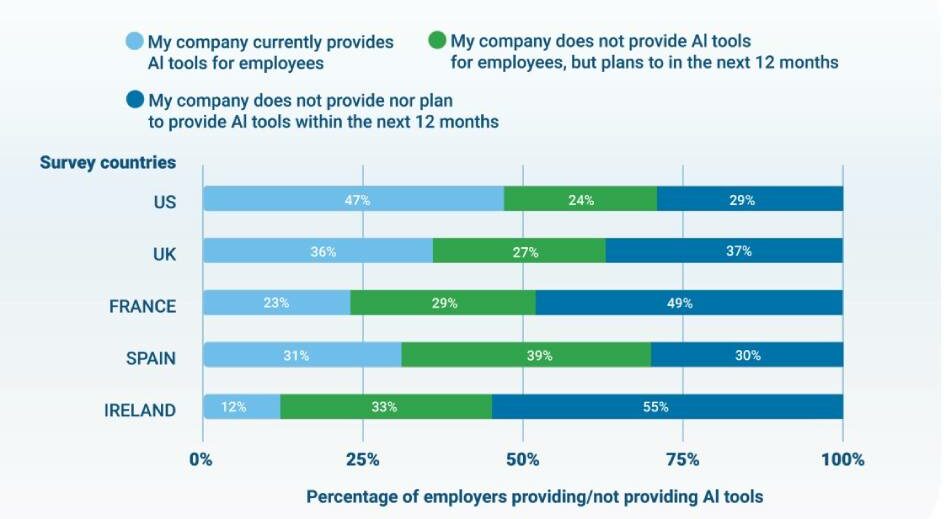With the AI revolution fully underway, we are all eager to understand what the future holds for the workforce. It seems like new surveys and research on labor trends appear every day, each with a different perspective. Much has been written about AI-driven productivity gains, and now, as businesses seek to capitalise on that opportunity, attention is turning to which workers and roles can benefit the most. This age-proofing AI approach naturally raises questions about one of the fastest-growing age groups in the labor force: older and midcareer workers…
How will they navigate these changes?
New Generation research in the US and Europe offers insights about how workers over the age of 45 might fare. With grant support from Google.org and The SCAN Foundation, we commissioned YouGov to survey two audiences – people age 45+ who work in entry- and mid-level roles, and hiring managers who evaluate candidates for these roles – across a range of industries and company sizes. We surveyed 2,610 employees and 1,488 employers in France, Ireland, Spain, the United Kingdom, and the United States during May and June 2024. The survey explored the rollout and use of AI tools – specifically generative AI tools, or those capable of generating content such as text, images, video, audio, or speech.
The survey audiences were:
People age 45+ who work in entry- and mid-level roles, 2,610 employees.
Hiring managers who evaluate candidates for these roles, 1,488 employers.
The insights that emerged provide a new perspective on the midcareer and older worker experience with AI in these countries. Three things stand out:
1. Employers predict a sharp drop in hiring, likely amplifiers of age bias
Our survey found that US and European employers anticipate declines ranging from 22% to 64% over the next 12 months in their entry-level and mid-level hiring. This trend was consistent across sectors and company size. Entry- and mid-level roles have been increasingly pursued by older workers in the US and Europe – whether they are people making career switches due to prior roles becoming obsolete, people who need to keep working into traditional “retirement” years to maintain financial security, or simply individuals who have made their careers in entry- or mid-level roles.
This finding – that entry-level and mid-level hiring is shrinking – is consistent with what we see in market data as well. According to TalentNeuron, a global source of labor data, entry-level tech roles, for
example, across the same countries we surveyed have declined 27% since early 2022.
Other interviews we conducted outside the YouGov survey with ~100 employers in late 2023 and early 2024, indicate that the reduced hiring is due to multiple factors: uncertainty about the future impact of AI on the volume of workers required in a role, shifts in corporate strategic priorities, and an increasingly cautious approach to the next phase of the economic cycle.
One clear risk from this anticipated hiring slowdown is that in a competitive labor market, pre-existing age biases may become even more challenging for older workers seeking employment. In previous Generation research from 2021 and 2023, employers expressed a consistent preference for younger hires. Asked to rate candidate strengths in 2021, employers overwhelmingly said younger candidates are more application-ready, have experience that is more relevant, and are a better fit with company culture relative to those in age 45+ age brackets. Similarly, in 2023, 47% of hiring managers said they would hire a candidate age 30-44 while only 13% said the same about candidates age 55+.
That hiring bias persisted, it’s worth noting, despite the fact that when we asked these same hiring managers about the job performance of midcareer and older workers whom they already employ, these negative perceptions were disproven. Employers reported that the midcareer and older workers they had hired consistently matched or exceeded the performance of younger colleagues, with 89% stating that midcareer and older workers performed as well if not better than younger peers.
In our new YouGov survey, hiring managers in both the US and Europe again told us they prefer younger candidates, expressing the belief we have seen before, that as they age, workers become less open to technology and new tools. That preference for younger candidates intensifies when considering roles that regularly use AI tools. In the US, 32% of employers said they would “likely” consider candidates over age 60 for such roles versus 90% who would likely consider candidates under age 35. Europe was very similar – with 33% likely to consider older candidates and 86% likely to consider the younger group
US hiring managers prefer younger candidates for roles that regularly use AI tools. European hiring managers also prefer younger candidates for roles that regularly use AI tools.
2. The Low levels of AI use among midcareer and older workers today may well be understating the growth potential
On the surface, it might appear employers’ age biases are well-founded. On average, just 15% of workers age 45+ across both Europe and the US reported that they are currently using AI in the workplace – ranging from 13% in the United States to 19% in Spain.
But consider that older workers may not need to rely on AI tools as heavily because they are less likely to use them to backfill an experience gap. A 2023 National Bureau of Economic Research study by MIT Sloan and Stanford academics that examined a large call center found that it was novice workers who enjoyed the biggest productivity gains from using AI tools – an increase of 34% – which helped them more quickly catch up to the skill level of those with years of experience. This study found that AI tools had “minimal impact on experienced and highly skilled workers” with regards to productivity boost.
Frequency of AI tool use at work by survey regions
Most importantly, just because many older workers don’t currently use AI doesn’t mean they can’t. In fact, our survey found that among midcareer and older workers who have adopted AI tools, the majority are self-taught and ‘power users’. As a “power user,” these older workers turn to AI tools multiple times a week, if not daily. More than half of midcareer and older workers in the US and two thirds in Europe who are using AI regularly reported that it is improving their work quality and pace, with nearly half of workers across all markets adding that it allows them to do more advanced or higher-level work, and about a third saying it helps them make better decisions. Thirty-five percent (35%) in the US and 58% in Europe even said AI makes their jobs more enjoyable.
3. Age-proofing AI: Employers have not yet cracked the code on what it will take to get the most out of AI
Encouraged by early signs of improvements in productivity and job satisfaction, employers across all industries are deploying AI solutions at a rapid pace. Nearly half of US hiring managers surveyed (47%)
reported that their companies have started providing AI tools, and that an additional 24% plan to do so in the next 12 months. While Europe’s transition is slower, change is underway there as well, with 29% of
employers saying they currently provide AI tools and 31% planning to in the next year (Figure 8).
Employers are rolling out AI tools in the workplace, though Europe lags the US pace.
Employer AI tool usage by survey country:
Note: US n= 564, UK n= 232, France n= 301, Spain n= 302, Ireland n= 89.
(Rows may not add to 100% due to rounding 10).
And almost all employers who have rolled out AI tools said they are providing some sort of training support to their workers – 94% in the US and 89% in the European countries surveyed.
Note: US n= 265, Europe n=257
But that support takes different forms. Roughly half (49%) of employers in our survey said that they provide formal training (51% in US and 41% in Europe), similar numbers offer peer or manager coaching, and then slightly more offer self-serve resources.
Even as change is underway, the vast majority of surveyed midcareer and older workers are still on the fence about the value of AI tools in the workplace today. While 24% of non-users who are age 45 and over in the US and 36% in Europe expressed interest in learning to use AI tools, another quarter were neutral or unsure. Most troubling, nearly a third of the non-users in the US and 17% in Europe declared they are not interested in AI at all, an attitude which, if it persists, may put this group at a higher risk of forced early retirement – and employers at risk of losing important institutional know-how.











